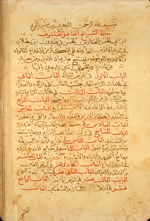Catalogue: Medical Monographs
The topic of medical care for isolated religious societies, such as Christian monasteries, is an unusual one amongst preserved Arabic treatises. Many of the medieval physicians were, however, Christians, and at least one, Ibn Buṭlān, became a monk following an active professional life as a physician. The medical care that Ibn Butlan prescribed for an isolated community of monks employed foodstuffs and medicaments that could be easily obtained or grown by that community. This genre of medical writing is related to medieval self-help manuals aimed at those who did not have access to a physician. An example of the latter is a popular treatise written in the late 9th century by al-Rāzī titled Kitab ila man la yahduruhu al-tabib (Book for Someone Who Does Not Have Access to a Physician); for the latter, see Savage-Smith, "Bodleian", MS Hunt. dont. 31 item 4 and MS Marsh 137 item 2.
-
 Kunnāsh al-adyirah wa-al-ruhbān (Compendium for Monasteries and Monks), or
Kunnāsh al-adyirah wa-al-ruhbān (Compendium for Monasteries and Monks), or - Fī tadbīr al-amrāḍ al-‘āriḍah ‘alá al-akthār min al-aghdhiyah al-ma‘lūfah wa-al-adwiyah al-mawṣufah li-yantaf‘u bi-hā ruhbān al-adyirah wa-man ba‘uda ‘an al-madīnah (MS A 37)
- (On the Management of Diseases for the Most Part Through Common Foodstuffs and Available Medicaments, Specifically for the Use of Monks of the Monasteries and Whoever is Far from the City),
- في تدبير الامراض العارضة على الاكثار من الاغذية المعلوفة والادوية الموصوفة لينتفع بها رهبان الاديرة ومن بعد عن المدينة / كناش الاديرة والرهبان
- by Abū al-Ḥasan al-Mukhtār ibn ‘Abdūn Ibn Buṭlān (d. 1066/458)
- ابو الحسن المختار ابن عبدون ابن بطلان
The Christian physician Ibn Buṭlān wrote an Arabic medical guide for monks residing in an isolated monastery which could also be of use to anyone away from urban medical care. The therapeutic guide, comprising 42 chapters (babs), employed only easily available medicaments and foodstuffs. Towards the end of his life, Ibn Buṭlān retired to a monastery in Antioch, in Syria, and became a monk.
In the copy now at NLM, the treatise has the lengthy title which translates as On the Management of Diseases for the Most Part Through Common Foodstuffs and Available Medicaments, Specifically for the Use of Monks of the Monasteries and Whoever is Far from the City, though it is more often referred to by its shorter title Compendium for Monasteries and Monks.
For the other five recorded copies of the treatise, see S. Y. Jadon, The Arab Physician Ibn Buṭlān's (d. 1066) Medical Manual for the Use of Monks and Country People [in Arabic] (unpublished Ph.D. dissertation, University of California, Los Angeles, 1968), 2 vols. In this edition of the Arabic text, Jadon employed the NLM copy. No modern translation of the treatise has been published.
Fī tadbīr al-amrāḍ al-‘āriḍah ‘alá al-akthār min al-aghdhiyah al-ma‘lūfah wa-al-adwiyah al-mawṣufah li-yantaf‘u bi-hā ruhbān al-adyirah wa-man ba‘uda ‘an al-madīnah (MS A 37)
Illustrations
The opening of the medical guide for Christian monks written by Ibn Buṭlān. The undated copy was possibly made in the 18th century.
Physical Description
Arabic. 45 leaves (fols. 1b-45b). Dimensions 20.2 x 15.3 (text area 15.0 x 9.7) cm; 21 lines per page. The title is given on fol. 1b, lines 4-5 as Fī tadbīr al-amrāḍ al-‘āriḍah ‘alá al-akthār min al-aghdhiyah al-ma‘lūfah wa-al-adwiyah al-mawṣufah li-yantaf‘u bi-hā ruhbān al-adyirah wa-man ba‘uda ‘an al-madīnah. On the title page, fol. 1a, a later hand has given a short generic title: al-Maqalah fī ‘ilm al-tibb (A Treatise on Medicine). The author's name appears at the start of the text, fol. 1b, line 3 .
The copy is undated and unsigned. The appearance of the paper, script, and ink suggests a date of the 18th century.
The copy is incomplete: folios are missing after fol. 31 and fol. 35 (comprising all or parts of babs 25-33 of the treatise), and the end of the 41st bab and all of the 42nd bab are missing. The text is written in a clear, large naskh script in gray ink mixed with black, with headings in red. There are catchwords.
There are some marginalia.
The yellowed paper is fairly opaque, with visible laid lines but traces only of chain lines. The paper is water damaged and wormeaten, with the lower corner especially damaged. Some folios hae been repaired.
The volume consists of 45 leaves.
Binding
The volume is bound in pink cloth with marbled paper over pasteboards. There are modern pastedowns and endpapers.
Provenance
The volume was purchased in 1941 by the Army Medical Library from A.S. Yahuda who acquired it in northern Iraq, in the town of Erbil (ELS 1707 med 66).
References
Schullian/Sommer, Cat. of incun. & MSS., entry p. A37, pp. 309-310.
NLM Microfilm Reel: FILM 48-119, no. 4.











